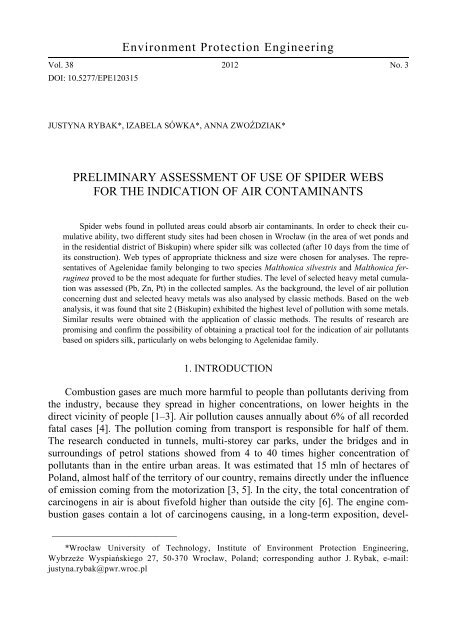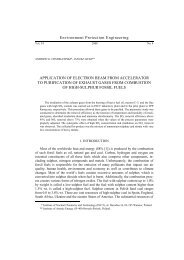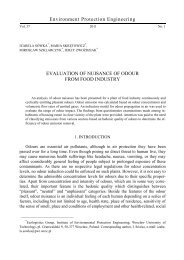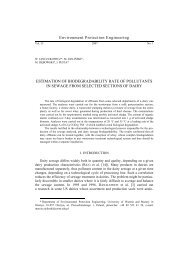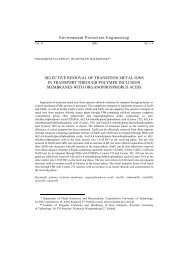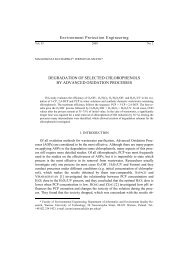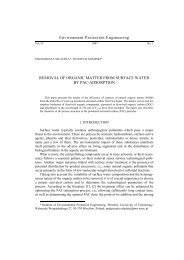Preliminary assessment of use of spider webs for the indication of air ...
Preliminary assessment of use of spider webs for the indication of air ...
Preliminary assessment of use of spider webs for the indication of air ...
You also want an ePaper? Increase the reach of your titles
YUMPU automatically turns print PDFs into web optimized ePapers that Google loves.
Environment Protection Engineering<br />
Vol. 38 2012 No. 3<br />
DOI: 10.5277/EPE120315<br />
JUSTYNA RYBAK*, IZABELA SÓWKA*, ANNA ZWOŹDZIAK*<br />
PRELIMINARY ASSESSMENT OF USE OF SPIDER WEBS<br />
FOR THE INDICATION OF AIR CONTAMINANTS<br />
Spider <strong>webs</strong> found in polluted areas could absorb <strong>air</strong> contaminants. In order to check <strong>the</strong>ir cumulative<br />
ability, two different study sites had been chosen in Wrocław (in <strong>the</strong> area <strong>of</strong> wet ponds and<br />
in <strong>the</strong> residential district <strong>of</strong> Biskupin) where <strong>spider</strong> silk was collected (after 10 days from <strong>the</strong> time <strong>of</strong><br />
its construction). Web types <strong>of</strong> appropriate thickness and size were chosen <strong>for</strong> analyses. The representatives<br />
<strong>of</strong> Agelenidae family belonging to two species Malthonica silvestris and Malthonica ferruginea<br />
proved to be <strong>the</strong> most adequate <strong>for</strong> fur<strong>the</strong>r studies. The level <strong>of</strong> selected heavy metal cumulation<br />
was assessed (Pb, Zn, Pt) in <strong>the</strong> collected samples. As <strong>the</strong> background, <strong>the</strong> level <strong>of</strong> <strong>air</strong> pollution<br />
concerning dust and selected heavy metals was also analysed by classic methods. Based on <strong>the</strong> web<br />
analysis, it was found that site 2 (Biskupin) exhibited <strong>the</strong> highest level <strong>of</strong> pollution with some metals.<br />
Similar results were obtained with <strong>the</strong> application <strong>of</strong> classic methods. The results <strong>of</strong> research are<br />
promising and confirm <strong>the</strong> possibility <strong>of</strong> obtaining a practical tool <strong>for</strong> <strong>the</strong> <strong>indication</strong> <strong>of</strong> <strong>air</strong> pollutants<br />
based on <strong>spider</strong>s silk, particularly on <strong>webs</strong> belonging to Agelenidae family.<br />
1. INTRODUCTION<br />
Combustion gases are much more harmful to people than pollutants deriving from<br />
<strong>the</strong> industry, beca<strong>use</strong> <strong>the</strong>y spread in higher concentrations, on lower heights in <strong>the</strong><br />
direct vicinity <strong>of</strong> people [1–3]. Air pollution ca<strong>use</strong>s annually about 6% <strong>of</strong> all recorded<br />
fatal cases [4]. The pollution coming from transport is responsible <strong>for</strong> half <strong>of</strong> <strong>the</strong>m.<br />
The research conducted in tunnels, multi-storey car parks, under <strong>the</strong> bridges and in<br />
surroundings <strong>of</strong> petrol stations showed from 4 to 40 times higher concentration <strong>of</strong><br />
pollutants than in <strong>the</strong> entire urban areas. It was estimated that 15 mln <strong>of</strong> hectares <strong>of</strong><br />
Poland, almost half <strong>of</strong> <strong>the</strong> territory <strong>of</strong> our country, remains directly under <strong>the</strong> influence<br />
<strong>of</strong> emission coming from <strong>the</strong> motorization [3, 5]. In <strong>the</strong> city, <strong>the</strong> total concentration <strong>of</strong><br />
carcinogens in <strong>air</strong> is about fivefold higher than outside <strong>the</strong> city [6]. The engine combustion<br />
gases contain a lot <strong>of</strong> carcinogens causing, in a long-term exposition, devel-<br />
________________________<br />
*Wrocław University <strong>of</strong> Technology, Institute <strong>of</strong> Environment Protection Engineering,<br />
Wybrzeże Wyspiańskiego 27, 50-370 Wrocław, Poland; corresponding author J. Rybak, e-mail:<br />
justyna.rybak@pwr.wroc.pl
176<br />
J. RYBAK et al.<br />
opment <strong>of</strong> cancer cells. The most dangerous are benzene, polycyclic aromatic hydrocarbons<br />
(PAH), dust and heavy metals. Dust is a serious threat. Coal particles have<br />
very high absorption capacity and <strong>the</strong>re<strong>for</strong>e diverse toxic substances settle easily on<br />
<strong>the</strong>ir surface, including carcinogenic hydrocarbons and heavy metals [7]. Dust participates<br />
in transporting <strong>the</strong>m inside <strong>the</strong> human body. It irritates eyes, skin and respiratory<br />
tract (pneumoconiosis). Diesel engines are main source <strong>of</strong> dust emission [8].<br />
As <strong>spider</strong> <strong>webs</strong> absorb <strong>air</strong> pollution from <strong>the</strong> environment, <strong>the</strong>y can be <strong>use</strong>ful indicators<br />
<strong>of</strong> <strong>air</strong> quality. The advantages <strong>of</strong> application <strong>of</strong> <strong>spider</strong> <strong>webs</strong> are as follows: low<br />
cost <strong>of</strong> samples collection, availability <strong>of</strong> <strong>the</strong> research material, secluded location preventing<br />
<strong>the</strong>ir destruction by wea<strong>the</strong>r conditions (falls, wind, snow) and people, noninvasiveness<br />
<strong>of</strong> studies (no need <strong>of</strong> killing animals), easy collection <strong>of</strong> samples. Moreover,<br />
studies conducted so far [9] show that cumulative ability <strong>of</strong> <strong>webs</strong> is an additional<br />
advantage. Such ability, being a consequence <strong>of</strong> its chemical structure, gives an unique<br />
opportunity to asses an <strong>air</strong> pollution level in a long-term period, contrary to <strong>the</strong> classic<br />
measurements which could only deliver in<strong>for</strong>mation about <strong>the</strong> temporary state <strong>of</strong> <strong>the</strong><br />
environment. Additionally, measurement <strong>of</strong> concentrations <strong>of</strong> pollutants is usually carried<br />
out with expensive and inconvenient equipment (large-sized and noisy apparatus).<br />
On <strong>the</strong> opposite, <strong>webs</strong> collection from tunnel walls is fast and enables one to study<br />
a long-term influence <strong>of</strong> pollutants only by single examinations (e.g. 7 or 30 days).<br />
Application <strong>of</strong> high-tech passive dosimeters <strong>for</strong>mally discredits <strong>the</strong> legitimacy <strong>of</strong><br />
<strong>webs</strong> <strong>use</strong>, however it is worth to emphasize that even a relatively cheap and simple<br />
dosimeters cannot be left in random places in case <strong>of</strong> <strong>the</strong>ft or destroy. Ano<strong>the</strong>r advantage<br />
is that <strong>webs</strong> are usually found in large numbers, <strong>of</strong>ten in places where it is hard to<br />
install <strong>the</strong> dosimeter and usually do not attract any attention. What is more, it is possible<br />
to date <strong>the</strong> time <strong>of</strong> <strong>the</strong> web exhibition to pollutants by removing <strong>the</strong> old web and<br />
using only a new construction.<br />
Cumulative ability <strong>of</strong> <strong>spider</strong> <strong>webs</strong> has not been analysed in Poland. Assessment <strong>of</strong><br />
<strong>use</strong>fulness <strong>of</strong> <strong>webs</strong> <strong>for</strong> <strong>the</strong> <strong>indication</strong> <strong>of</strong> <strong>the</strong> environment is <strong>the</strong> aim <strong>of</strong> presented studies.<br />
The obtained results could contribute to <strong>the</strong> development <strong>of</strong> an easy method <strong>of</strong><br />
pollution <strong>indication</strong> which can function almost all year round (<strong>webs</strong> can be obtained<br />
under laboratory conditions by breeding <strong>spider</strong>s) which could be an additional advantage<br />
<strong>of</strong> <strong>the</strong> method, unlike <strong>the</strong> majority <strong>of</strong> bio<strong>indication</strong> methods where application is<br />
<strong>of</strong>ten limited only to <strong>the</strong> vegetative season (e.g. <strong>assessment</strong> <strong>of</strong> water quality based on<br />
benthic macroinvertebrates) [10, 11].<br />
2. EXPERIMENTAL<br />
Webs were collected from <strong>the</strong> two following study sites within city <strong>of</strong> Wrocław.<br />
Site 1. Hydrotechnical building on water supplying areas <strong>of</strong> Wrocław (wet ponds)<br />
is located in <strong>the</strong> south-east part <strong>of</strong> <strong>the</strong> city. A flat area (1026 hectares) consisted <strong>of</strong>
Spider <strong>webs</strong> <strong>for</strong> <strong>the</strong> <strong>indication</strong> <strong>of</strong> <strong>air</strong> contaminants 177<br />
meadows, only partly overgrown with bush and trees, covered with <strong>the</strong> system <strong>of</strong><br />
ditches and channels supplying water to 63 infiltration ponds. Drinking water is delivered<br />
<strong>for</strong> <strong>the</strong> city <strong>of</strong> Wrocław from this area and from <strong>the</strong> river Oława, which is fed<br />
with water from Nysa Kłodzka. The area lies distantly from <strong>the</strong> main communications<br />
trails. Spider silk was collected from <strong>the</strong> hydrotechnical building.<br />
Site 2. Biskupin, <strong>the</strong> housing estate which is situated in <strong>the</strong> eastern part <strong>of</strong> Wrocław,<br />
in Śródmieście district. Odra River constitutes its natural south border. Surroundings<br />
are diversified including areas <strong>of</strong> allotments, parks, high buildings (postwar<br />
tenements) and low buildings (detached ho<strong>use</strong>s). Spider silk was collected from<br />
fences and walls separating premises <strong>of</strong> Kosiby street.<br />
Webs <strong>of</strong> two species: Malthonica silvestris (site 1) and Malthonica ferruginea<br />
(site 2) have been analysed, both belonging to Agalenidae family. Malthonica silvestris<br />
constructs triangular <strong>webs</strong> leng<strong>the</strong>ning to <strong>the</strong> funnel where <strong>the</strong> <strong>spider</strong> stays all day<br />
long (retreat). This species inhabits <strong>for</strong>ests, places under stones, roots and blown down<br />
trees. Moreover, it is possible to find M. silvestris in ruins, tunnels, as well as in caves<br />
[12]. Malthonica ferruginea (with rust-coloured abdomen lives in <strong>for</strong>ests or in surroundings<br />
<strong>of</strong> human residences. Both species belong to <strong>the</strong> same family, weave <strong>the</strong><br />
similar structure (web <strong>of</strong> similar density), thus it was possible to compare <strong>the</strong> cumulative<br />
ability <strong>of</strong> this construction in both sites.<br />
Agelenidae family prefers dark, derelict and neglected buildings, its representatives<br />
can also be found in tunnels and under bridges. Webs are not sticky (as <strong>webs</strong> <strong>of</strong><br />
many representatives <strong>of</strong> Ecribellatae suborder), consist <strong>of</strong> an opened residential tube<br />
which widens at <strong>the</strong> front into <strong>the</strong> funnel but its lower part changes into an extensive<br />
silk carpet with numerous signal threads, in<strong>for</strong>ming <strong>the</strong> <strong>spider</strong> <strong>of</strong> preys passing by.<br />
Flies and o<strong>the</strong>r insects are <strong>the</strong> main prey <strong>of</strong> Agelenidae [12].<br />
In order to check whe<strong>the</strong>r <strong>spider</strong> <strong>webs</strong> are able to indicate <strong>the</strong> pollution level exceeding<br />
background values, concentrations <strong>of</strong> selected metals were defined and compared<br />
only among <strong>webs</strong> <strong>of</strong> newly constructed and <strong>the</strong>n collected in both study sites.<br />
The dependence <strong>of</strong> <strong>webs</strong> distance from <strong>the</strong> source <strong>of</strong> emission and <strong>the</strong> influence <strong>of</strong><br />
<strong>webs</strong> age on <strong>the</strong> level <strong>of</strong> cumulation is <strong>the</strong> crucial matter which has already been<br />
proved in previous studies [9]. These findings were taken into consideration in presented<br />
analyses.<br />
Webs <strong>of</strong> both species were collected from April to <strong>the</strong> end <strong>of</strong> May in 2009. Only<br />
new constructions were taken into consideration. For that purpose, <strong>the</strong> area <strong>of</strong> studies<br />
was marked and photographed in detail and all old constructions were removed. Once<br />
a day sites were controlled in order to notify <strong>the</strong> appearance <strong>of</strong> <strong>the</strong> new <strong>webs</strong>. New<br />
constructions were collected after each 10 days.<br />
After <strong>the</strong> defined time <strong>the</strong> silk was ga<strong>the</strong>red into clean glass phials with glass, sterile<br />
baguettes, <strong>the</strong>n <strong>webs</strong> were frozen <strong>for</strong> <strong>the</strong> future chemical analyses (<strong>the</strong> method after<br />
Hose et al. [13]). For mineralization purpose, <strong>the</strong> samples were defrosted, dried by
178<br />
J. RYBAK et al.<br />
48 h at 70 °C and weighed with <strong>the</strong> accuracy <strong>of</strong> 0.0001 mg, digested in nitric acid<br />
(70%) and warmed <strong>for</strong> drying <strong>of</strong>f. Samples were suspended again in nitric acid, and<br />
<strong>the</strong>n hydrogen peroxide was added (30%). Remains were again suspended in nitric<br />
acid and warmed to 120 ° to total digesting. Next, samples were analysed <strong>for</strong> <strong>the</strong> Pb,<br />
Zn and Pt presence. Elements chosen <strong>for</strong> analyses are pollutants most toxic <strong>for</strong> humans.<br />
ICP-MS, ICP-OES and AAS analyses were made in a Chemical Laboratory <strong>of</strong><br />
Multi-Elemental Analyses, Institute <strong>of</strong> Inorganic Technology and Mineral Fertilizers<br />
in <strong>the</strong> Chemical Department <strong>of</strong> Wrocław University <strong>of</strong> Technology. The analytical<br />
scheme applied at <strong>the</strong> laboratory gives <strong>the</strong> possibility <strong>of</strong> per<strong>for</strong>ming multi-elemental<br />
analyses. A low detection limit enables determining concentrations <strong>of</strong> elements <strong>of</strong><br />
ultratrace level (with <strong>the</strong> application <strong>of</strong> <strong>the</strong> most sensitive technique ICP-MS), microelements<br />
(ICP-OES with an ultrasonic nebuliser) and macroelements (ICP-OES with<br />
a pneumatic nebuliser). Determining <strong>of</strong> a wide range <strong>of</strong> concentrations, with <strong>the</strong> <strong>use</strong> <strong>of</strong><br />
all sorts <strong>of</strong> ICP apparat<strong>use</strong>s enables a precise analysis <strong>of</strong> a delicate material such as<br />
<strong>spider</strong> silk (<strong>the</strong> sensitivity <strong>for</strong> Pt and Pb was 0.2 ppm and <strong>for</strong> Zn 0.01 ppm).<br />
As a background, <strong>the</strong> level <strong>of</strong> <strong>air</strong> pollution with dust PM2.5 (dust particles smaller<br />
than 2.5 μm) was analysed on both sites by classic methods. The samples collection<br />
per<strong>for</strong>med in <strong>the</strong> period <strong>of</strong> March–May <strong>of</strong> 2009 contained twenty-four hour samples<br />
<strong>of</strong> PM2.5 dust) within <strong>the</strong> area representing <strong>the</strong> municipal background (site 1) and<br />
urban area (site 2). Twenty-four hour PM2.5 samples were taken with <strong>the</strong> impactor<br />
which has been applied in <strong>the</strong> United States <strong>for</strong> a dozen years in <strong>the</strong> program <strong>of</strong> Interagency<br />
Monitoring <strong>of</strong> Protected Visual Environment IMPROVE [14]. Dust was collected<br />
on Teflon filters (Whatman, 2 µm PTFE 46.2 mm, <strong>air</strong> flow 22.8 dm 3 /min).<br />
Analyses <strong>of</strong> chemical composition were per<strong>for</strong>med with <strong>the</strong> fluorescence technique, <strong>of</strong><br />
X-ray XRF, PIXE (induced X-Ray energy proton) and PESA (proton elastic scattering<br />
analysis) in PANalytical (Almelo, <strong>the</strong> Ne<strong>the</strong>rlands). The details <strong>of</strong> sampling and <strong>the</strong><br />
accuracy <strong>of</strong> analytical methods have been presented by Horemans et al. [15]. PESA is<br />
usually applied in studies <strong>of</strong> hydrogen concentrations in samples. Concentrations <strong>of</strong><br />
22 elements have been analysed (H, S, Cl, K, Ca, Ti, Fe, Mn, Cr, V, Ni,Cu, Zn, As, Pb,<br />
Sr, Br, Rb, Sr, Na, Al, I i Si). All data were analysed with t- test (critical value 0.05).<br />
3. RESULTS<br />
Both sites were significantly different (P < 0.05) concerning <strong>the</strong> concentration <strong>of</strong><br />
Pb, Zn and Pt in new constructions <strong>of</strong> M. silvestris and M. ferruginea. Table 1 shows<br />
average concentrations <strong>of</strong> metals cumulated in <strong>webs</strong> <strong>for</strong> both species <strong>of</strong> <strong>spider</strong>s in two<br />
studied areas. Figure 1 shows average concentrations <strong>of</strong> elements recorded within <strong>the</strong><br />
area <strong>of</strong> municipal background (site 1) and in <strong>the</strong> city centre <strong>of</strong> Wrocław (site 2). Aver-
Spider <strong>webs</strong> <strong>for</strong> <strong>the</strong> <strong>indication</strong> <strong>of</strong> <strong>air</strong> contaminants 179<br />
age twenty-four hour Pb and Zn concentrations differed significantly (P < 0.05).<br />
Higher concentrations were generally observed in <strong>the</strong> municipal atmosphere.<br />
Air pollution [ng/m 3 ]<br />
10000<br />
1000<br />
100<br />
10<br />
1<br />
0.1<br />
Table 1<br />
Average concentrations <strong>of</strong> metals (± standard deviation)<br />
in newly constructed <strong>webs</strong> <strong>of</strong> M. silvestris and M. ferruginea (sites 1 and 2)<br />
M. silvestris<br />
Pb<br />
Zn<br />
Pt<br />
M. ferruginea<br />
Pb<br />
Zn<br />
Pt<br />
Species Site 1 Site<br />
45±6 µg/g<br />
201±26 µg/g<br />
27±5 ng/g<br />
–<br />
–<br />
–<br />
4. DISCUSSION<br />
site 1 site 2<br />
–<br />
–<br />
–<br />
85 ±4 µg/g<br />
317±12 µg/g<br />
67±23 ng/g<br />
S K Ca Ti V Cr Mn Fe Ni Cu Zn As Pb Se Br Rb Sr Na Al. Si<br />
Fig. 1. Average concentrations <strong>of</strong> elements recorded within <strong>the</strong> area<br />
<strong>of</strong> <strong>the</strong> municipal background (site 1) and in <strong>the</strong> city centre <strong>of</strong> Wrocław (site 2)<br />
The obtained results show a relatively high level <strong>of</strong> metals content in both sites.<br />
Site 1, as web analysis shows, was characterised by a relatively high concentration <strong>of</strong><br />
Zn (water-supplying areas) compared with studies conducted by Hose et al. [13]. Such<br />
high values are surprising; <strong>the</strong>y could be result <strong>of</strong> limited, but still present car traffic in<br />
this area or in general <strong>the</strong> high concentration <strong>of</strong> Zn in <strong>the</strong> municipal background.<br />
Nowadays, brake pads are primary source <strong>of</strong> lead [16]. Engine oil, tyres usage are <strong>the</strong>
180<br />
J. RYBAK et al.<br />
basic source <strong>of</strong> pollution with zinc [17]. However, it can also originate from corrode<br />
<strong>of</strong> building materials [18]. Differences in Zn, Pb and Pt content in <strong>webs</strong> compared<br />
with <strong>the</strong> results achieved by Hose et al. [13] could also be connected with <strong>the</strong> age <strong>of</strong><br />
studied <strong>webs</strong>. A choice <strong>of</strong> <strong>spider</strong> species <strong>for</strong> studies could be also important factor<br />
influencing results (Hose et al. [13] examined <strong>webs</strong> <strong>of</strong> species which are not recorded<br />
in Poland), thus such comparison could only give rough values.<br />
The emission deriving from transport decreased significantly since <strong>the</strong> introduction<br />
<strong>of</strong> lead-free petrol, however application <strong>of</strong> catalytic converters ca<strong>use</strong>s <strong>the</strong> emission<br />
<strong>of</strong> o<strong>the</strong>r harmful metal – platinum. Platinum is teratogenic (by damaging <strong>the</strong> foetus),<br />
is excreted with urine leading to kidneys injuries. Small amounts <strong>of</strong> platinum<br />
compounds are also strong allergens [3]. However, concentrations recorded in our<br />
studies are surprisingly high, posing a great threat to people and environment. The<br />
content <strong>of</strong> this element in <strong>spider</strong> silk has never been analysed, <strong>the</strong>re<strong>for</strong>e it is not possible<br />
to make any comparison. However, it is possible to compare <strong>the</strong> results <strong>of</strong> <strong>the</strong><br />
study with <strong>the</strong> concentrations recordec in dust collected in <strong>the</strong> vicinity <strong>of</strong> busy streets<br />
<strong>of</strong> Beijing. The obtained values were from 3.96 to 356.3 ng/g, however referential<br />
sites cumulated from 0.1 to 0.9 ng/g <strong>of</strong> Pt [18]. In our studies, site 2 achieved <strong>the</strong><br />
highest value (67 ng/g), site 1 was characterised by much lower value (27 ng/g) but<br />
not as low as got referential site in Beijing.<br />
Analyses per<strong>for</strong>med with <strong>the</strong> <strong>use</strong> <strong>of</strong> classic methods show that site 2 is generally<br />
characterised by higher level <strong>of</strong> <strong>air</strong> pollution (Fig. 1) and achieved values <strong>for</strong> Pb<br />
23 ng/m 3 and Zn 54 ng/m 3 . However, in <strong>the</strong> area <strong>of</strong> municipal background (site 1) contents<br />
<strong>of</strong> Pb were 13 ng/m 3 and Zn 27 ng/m 3 . When we compare <strong>the</strong> recorded concentrations<br />
<strong>of</strong> Pb and Zn in Wroclaw with literature data it can be concluded that <strong>the</strong>y fall<br />
within <strong>the</strong> range which was obtained in <strong>the</strong> world. Average concentration <strong>of</strong> Zn in <strong>the</strong><br />
atmosphere <strong>of</strong> urban agglomeration <strong>of</strong> Cincinnati, USA, obtained from a few measuring<br />
sessions, was 10–211 ng/m 3 depending on <strong>the</strong> season and location <strong>of</strong> measuring stations<br />
[19]. The highest values were recorded in <strong>the</strong> period from August to September in <strong>the</strong><br />
city centre. Pb concentrations were much lower, from 3 to 28 ng/m 3 . In Vienna (Austria)<br />
annual average values, in <strong>the</strong> municipal area, were Zn <strong>for</strong> and Pb from 22 to 17 <strong>of</strong><br />
ng/m 3 , however in <strong>the</strong> area located 30 km away from <strong>the</strong> city <strong>the</strong> values were lower,<br />
appropriately 17 and 12 ng/m 3 [20]. Next, in <strong>the</strong> fast developing cities <strong>of</strong> Asia concentrations<br />
<strong>of</strong> Zn and Pb were 245 and 79 ng/m 3 [21]. Never<strong>the</strong>less, it should be taken into<br />
account that annual values are always averaged from measurements conducted within<br />
a year and are usually lower than <strong>the</strong>se recorded at short periods <strong>of</strong> time.<br />
5. CONCLUSIONS<br />
The aim <strong>of</strong> our studies was a preliminary <strong>assessment</strong> <strong>of</strong> <strong>the</strong> possibilities <strong>of</strong> <strong>use</strong> <strong>of</strong><br />
<strong>spider</strong> <strong>webs</strong> <strong>for</strong> <strong>the</strong> <strong>indication</strong> <strong>of</strong> main <strong>air</strong> pollutants. The results <strong>of</strong> <strong>the</strong> study are prom-
Spider <strong>webs</strong> <strong>for</strong> <strong>the</strong> <strong>indication</strong> <strong>of</strong> <strong>air</strong> contaminants 181<br />
ising and confirm <strong>the</strong> working <strong>the</strong>sis that <strong>webs</strong> can serve as an effective tool <strong>for</strong> <strong>the</strong><br />
<strong>indication</strong> <strong>of</strong> pollutants. Webs <strong>of</strong> two Agelenidae representatives <strong>use</strong>d in ours research<br />
should be taken into account particularly beca<strong>use</strong> <strong>of</strong> <strong>the</strong>ir very good cumulative properties<br />
deriving from high density.<br />
ACKNOWLEDGEMENTS<br />
The work was financed by Minister <strong>of</strong> Science and <strong>of</strong> Higher Education, research project No.<br />
N N305 096639.<br />
REFERENCES<br />
[1] KONIECZYŃSKI J., PASOŃ-KONIECZYŃSKA A., Inż. Środ., 2003, 48, 89 (in Polish).<br />
[2] ROGULA-KOZŁOWSKA W., PASTUSZKA E., TALIK E., Pol. J. Environ. Stud., 2008, 17 (4), 539.<br />
[3] SUCHECKI B., ZOWSIK M., RYTEL K., KASSENBERG A., Effects <strong>of</strong> road transport on human health,<br />
Zielone Mazowsze, Warszawa, 2006 (in Polish).<br />
[4] KÜNZLI N., KAISER R., MEDINA S., STUDNICKA M., CHANEL O., FILIGER P., HERRY M., HORAK F.,<br />
PUYBONNIEUX-TEXIER V., QUÉNEL P., SCHNEIDER J., SEETHALER R., VERGNAUD J.-C., Lancet, 2000,<br />
35 (2), 795.<br />
[5] ROGULA W., PASTUSZKA E, TALIK E., Arch. Ochr. Środ., 2007, 33 (2), 23 (in Polish).<br />
[6] Bay Area Air Quality Management District, Toxic Air Contaminant Control Program, Annual Reports<br />
<strong>for</strong> 2002, Vol. 1, June 2004.<br />
[7] JERMANN E., HAJIMIRAGHA H., BROCKAHUS A., FREIER J., EWERS U., ROSCOVANU A., Zentralbl. Hyg.<br />
Umweltmed., 1989, 189, 50.<br />
[8] ZHU Y., HINDS W.C., SHEN S., KIM S., SIOUTAS C., Atmos. Environ., 2002, 36, 4323.<br />
[9] XIAO-LI S., YU P., HOSE G.C., JIAN C., FENG-XIANG L., Bull Environ. Contam. Toxicol., 2006, 76, 271.<br />
[10] RYBAK J., Environ. Protect. Eng., 2009, 35 (1), 111.<br />
[11] OBOLEWSKI K., Ochr. Środ., 2009, 31 (2), 17 (in Polish).<br />
[12] ROBERTS M.J., Spiders <strong>of</strong> Britain and Nor<strong>the</strong>rn Europe. Collins Field Guide, Harper Collins, London,<br />
1995.<br />
[13] HOSE G.C., JAMES J.M., GRAY M.R., Environ. Pollut., 2002, 120, 725.<br />
[14] AL-MASRI M.S., AL-KHARFAN K., AL-SHAMALI K., Atmos. Environ., 2006, 40, 753.<br />
[15] HOREMANS B., WOROBIEC A., BUCZYNSKA A., VAN MEEL K., VAN GRIEKEN R., J. Environ. Monit.,<br />
2008, 10, 867.<br />
[16] DE MIGUEL E., LAMAS J.F., CHACON E., BERG T., LARSSEN S., ROYYET O., VADSET M., Atmos. Environ.,<br />
1997, 31 (17), 2733.<br />
[17] STERNBECK J., SJODIN A., ANDRÉASSON K., Atmos. Environ., 2002, 36 (30), 4735.<br />
[18] WANG J., ZHU R., SHI Y., China J. Environ. Sci., 2007, 19, 29.<br />
[19] MARTUZEVICIUS D., GRINSHPUN S., REPONEN T., GÓRNY R., SHUKLA R., LOCKEY J., HU S.,<br />
MCDONALD R., BISWAS P., KLUCININKAS L., LEMASTERS G., Atmos. Environ., 2004, 38, 1091.<br />
[20] PUXBAUM H., GOMISCEK B,, KALINA M., BAUER H., SALAM A., STOPPER S., PREINING O., HAUCK H.,<br />
Atmos. Environ., 2004, 38, 3949.<br />
[21] FANG G., CHANG CH., WU Y., FU P., YANG CH., CHEN CH., CHANG S., Atmos. Environ., 2002, 36,<br />
1921.


